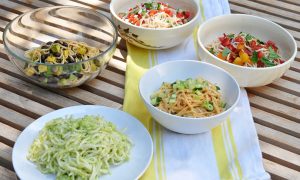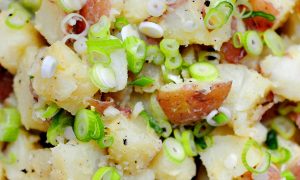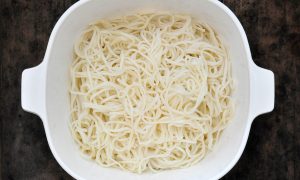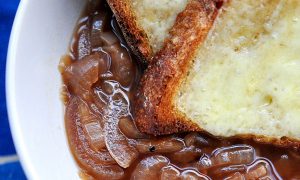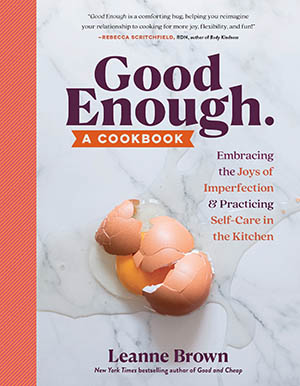Pumpkin Pie with John Sexton
NOTE: I have a newer, simpler, arguably better version of this recipe. I recommend making that one instead!
A few weeks back I got a call from NYU. Would I like to teach the NYU President to make a pumpkin pie for Thanksgiving? On camera? And it’ll help to promote the NYU combined campaign, which raises money for local non-profits? Done and done.
This recipe is definitely not simple. It has a lot of steps to ensure your crust is buttery, flaky and crisp. It might not be an everyday recipe, but it’s worth it for the holiday. Another plus, pies keep well so they are a great thing to make in the days leading up to Thanksgiving.
Pumpkin pies are delicious and of course, traditional, but if you prefer sweet potato or butternut squash you can substitute them for the pumpkin puree, or even do a blend of sweet potato and pumpkin. This is my favorite style, with the dark richness of molasses in the brown sugar and a strong hit from the cinnamon and spices. Don’t forget to add cinnamon to your whipped cream, it makes all the difference!
- 1/2 cup butter (1 stick)
- 1 1/4 cups all purpose flour
- 1/2 tsp salt
- 4 to 6 Tbsp ice water
- 1 egg yolk
- 2 cups pumpkin or squash puree
- 1 cup whipping cream
- 2 large eggs
- 3/4 cup dark brown sugar packed
- 1/2 tsp salt
- 1 Tbsp orange zest (about 1 small orange worth)
- 2 tsp cinnamon
- 1 tsp ginger powder
- 1 tsp cardamom
- 1/2 tsp nutmeg freshly grated
- 1/4 tsp cloves
- 1 cup whipping cream
- 4 tsp sugar
- 1/2 tsp cinnamon
- Cut the stick of butter into small chunks, approximately 8 to 12 pieces. Set them in a small bowl in the freezer for 20 to 30 minutes.
- While the butter chills, add the flour and salt to your food processor.
- Add the butter to the flour mixture in the food processor. Pulse the mixture 3 to 4 times until the butter pieces are chopped up into bean sized chunks.
- Add 4 tablespoons of water and pulse again. Add water a tablespoon at a time, pulsing as little as possible in between until the mixture looks like it is just able to come together. It should be very shaggy and chunky. You want to have bits of butter popping throughout the pastry—that's what creates flakiness.
- Dump the mixture out onto a clean countertop and bring it together into a rough disc shape using your hands. Cover it with plastic wrap and leave it in the fridge for an hour.
- After an hour, remove the dough from the fridge and let it rest on the counter for 5 minutes so you can roll it out more easily.
- Set the oven to 425 degrees F.
- Sprinkle a clean counter liberally with flour. Use a rolling pin to roll out the dough straight in front of you. Once you have rolled a couple of times, pick up the dough and flip it over. Then rotate the dough 90 degrees. Roll out the dough another couple of times. Flipping it and rotating it will keep it from sticking to the countertop and help you make an even circle. Sprinkle more flour onto the counter if anything gets sticky. Don't be shy with the flour! Repeat this process until you have a large enough circle of dough to fit your pie plate, with some excess. You want to have pastry that is hanging over the edge of the pie plate, because it helps create a nice edge and lets you fix any mistakes you make.
- Transfer the dough to a 9 inch pie plate and press it gently in place. You want about an inch of excess pastry hanging all the way around the rim. Trim away any pieces that are longer. Use your fingers in a pinching motion to roll excess dough up to create an edge on the lip of the pie plate. Squish this down with your fingers or a fork to create a rim around the lip of the pie. Alternatively, use a pinching motion to crimp the edge.
- Prick the pie dough all over with a fork—this lets the air out while it bakes and helps to keep it from shrinking too much. Now cover the whole pastry with aluminum foil, pressing all around to cover the edges as well. Now pour dried beans (or some people use pennies) into the aluminum foil covered crust. These will weight the crust down and allow it to cook evenly without puffing up and shrinking.
- Bake the crust with the dried beans for 15 minutes. This is called blind-baking. It's a useful method when pie filling has a shorter cooking time than the crust, as is the case here.
- While the crust bakes, add all the ingredients for the filling to a large bowl and whisk it together until it is smooth and homogenous, being particularly careful to blend the eggs fully into the mixture.
- Remove the blind-baked crust from the oven and let it cool for a few minutes before removing the pie weights. Turn the oven temperature down to 400 F. Remove the aluminum foil carefully and prick the crust all over with a fork again.
- Whisk the egg yolk in a small bowl. Use a pastry brush to gently brush the yolk all over the par-baked crust. Bake the crust for 5 more minutes. This step creates a moisture barrier between the crust and the pie filling, further ensuring that your crust will be crisp, even on the bottom of the pie.
- After 5 minutes, pull the crust out of the oven and pour in the pie filling. Very carefully place the pie back in the oven and bake for 45 minutes. After 45 minutes check to see if the center is still jiggly by gently shaking the pie back and forth. If it doesn't move too much in the middle it's ready, if it still jiggles, give it up to 15 more minutes in the oven.
- Once the filling is no longer jiggly, pull it out of the oven and let it cool to room temperature. Once it's cool enough, transfer it to the fridge to chill for 2 hours or overnight.
- 15 minutes before serving, add the cream, sugar and cinnamon to a bowl and whisk until stiff peaks form.
- Slice the pie into pieces and serve with a dollop of cinnamon-whipped cream on top. Enjoy your hard work!
Tip: If you have excess pastry, you can roll it out again, create shapes and bake it. Brush it with egg and sprinkle it with sugar and they make nice decorations for the pie. You can also eat them as little cookies with coffee or tea.
